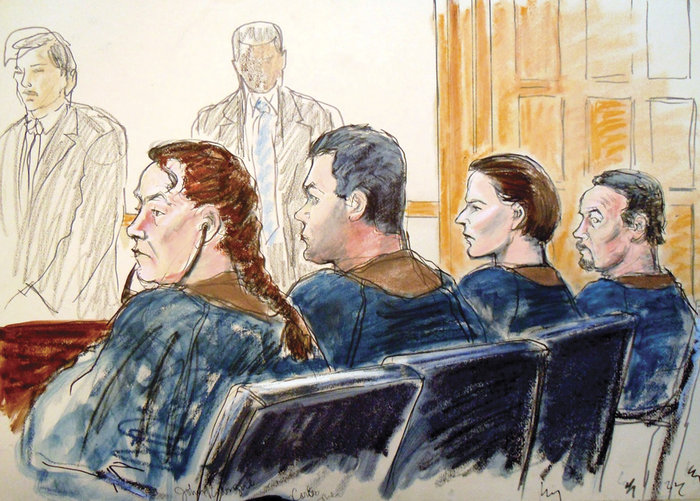In the age of a 24-hour news cycle where people have instant access to inordinate amounts of information and images, no major event seems off limits to cameras – with the exception of what takes place inside many courtrooms. Throughout many high-profile cases over the last several decades, two women have served witness inside the courtroom with their pens and brushes, coloring in the scene and capturing the only visual imprint available to most.
Award-winning artists Elizabeth Williams and Aggie Kenny have covered some of the nation’s most riveting trials including Watergate, Roe vs. Wade, Son of Sam, Bernie Madoff, and Martha Stewart.
Their works are currently on display at the 1200 Gallery in Hoboken in “Courtroom Art,” an exhibition presented by the Mason Civic League, which runs through March 2013.
Illustrating modern day history
“There is visual news and there is verbal news and the two have to go together,” said Councilwoman Beth Mason last week at the gallery. “This space is to generate community conversations to learn about what happened and why it happened.”
“This is a part of modern day history,” said Williams last week at the 1200 Gallery, located at 12th and Washington St. Williams’ artwork has been published on the covers of numerous international and national publications – including The New York Times, Wall Street Journal and USA Today – and exhibited at galleries throughout the country. Her work includes the trials of mobster John Gotti, Martha Stewart, Bernard Madoff, and John DeLorean, among many others.
Williams noted that the courtroom illustrations are a great way to introduce people to history and events.
“These are drawings that really represent the scene,” said Williams. “Joel Aurnou, Jean Harris’s lawyer, actually put his foot up on the table during the trial. Imagine that.” Williams referred to a drawing by Kenny that caught that detail.
Jean Harris, who passed away last December, made national headlines in the early 1980s when she was convicted of murdering Dr. Herman Tarnower, her lover. Her New York trial, which lasted 14 weeks, was one of the longest in the state’s history. She spent 12 years in jail.
Not far from the image of Harris’s lawyer with his foot up on a desk is Solomon Dwek – someone whom many in Hudson County will recognize – an FBI informant who offered bribes to local political officials and candidates in a statewide sting operation in 2009. The illustration depicts him on the witness stand. Dwek’s dealings had a profound impact on politics in Hudson County, leading to arrests of local mayors including Dennis Elwell in Secaucus and Peter Cammarano in Hoboken, who were brought in along with 40 others.
Outlining fast against deadlines
Kenny won an Emmy Award for her work on trial coverage for the CBS Evening News, and has also worked for ABC News and the Associated Press. She has also covered trials including Martin Luther King Jr. assassin James Earl Ray, the Black Panthers, and Jerry Sandusky.
“We are actually drawing as you would at the turn of the century,” said Kenny.
While media outlets depend on the old school drawings to capture the essence of what transpires inside America’s courtrooms, the artists have modified their techniques to meet ever increasing pressure and deadlines to turn a sketch around fast.
“They really want it ASAP,” said Kenny. She noted that during the Oliver North proceedings that took place in the late eighties she had more time to draw. She used watercolor, pencil, and gouache whereas now she uses pen to “get the scene down,” and also has her watercolor on hand.
For the Martha Stewart trial scene, Williams used oil paint stick, marker, Cray-Pas, and colored pencil. She noted that she had an hour and a half to draw, which is considered a long time.
However, for the Madoff trial, she had very little time and used a wash technique.
“They are saying to me, ‘When are you going to get it done?” said Williams about CNBC.
When the artists are pushed to produce under incredible amounts of pressure, they operate on automatic pilot.
“You are so focused to getting it to a finished state,” said Williams.
Kenny added that she tunes out anything else that is going on around her.
Likeness above all else
Sometimes the artists have the opportunity to sit in a courtroom for days and learn the faces of the individuals they are drawing. For this reason Williams loves covering bankruptcy trials. Other times, during an arraignment, the sketch artists only have five minutes. But even with time to draw, if a witness takes the stand and suddenly causes an uproar – then the artists need to work quickly to capture the expression and gestures.
“If you miss a likeness, you have hundreds of people telling you that you did,” said Williams. “You’ve gotta have it pretty much close.”
Both artists agreed that studying photos before a trial doesn’t help because people often look different in person.
Book and blog
CUNY Journalism Press, the academic imprint of the City University of New York’s Graduate School of Journalism, will publish “The Illustrated Courtroom: 50 Years of Court Art” in early 2014, which features some of the best work of five award-winning illustrators including Kenny and Williams.
The Hoboken exhibit runs until March 2013 at the 1200 Gallery.
Gallery hours are Thursday through Saturday from 3 p.m. to 9 p.m. For more information, call (201) 706-8088 or go to www.gallery1200.org. For more information on the works in the exhibit, please go to www.illustratedcourtroom.blogspot.com.
Adriana Rambay Fernández may be reached at afernandez@hudsonreporter.com.
